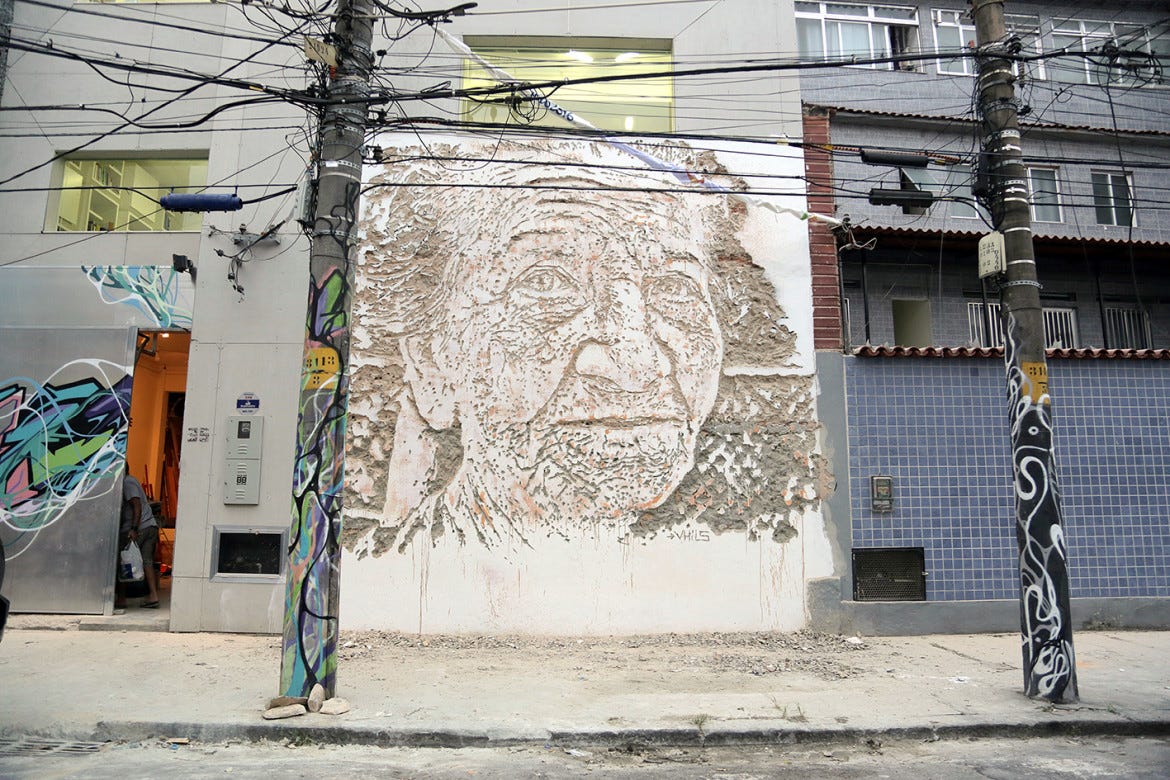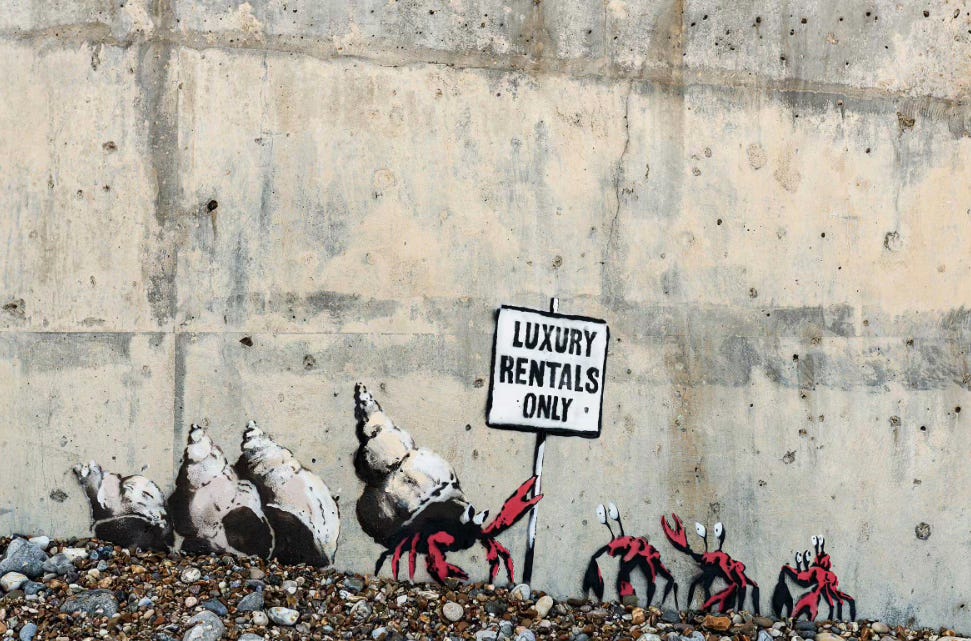The Urban Revolution (Vol 1): Vhils and the Vanguard of Street Art
Chiseling Change: Revolutionizing Urban Narratives through Innovative Street Art

Introduction
In this article, I’d like to explore the captivating world of street art, with a special focus on the groundbreaking work of Alexandre Farto, popularly known as Vhils. His unique approach to street art sets him apart as a modern-day urban archaeologist, revealing hidden layers of history and emotion etched in city walls.
I first encountered Vhils' work while living in Lisbon in 2010, which now feels like almost a lifetime ago. Back then, Vhils was just beginning to gain recognition and appear more frequently in the media.
I was immediately captivated not only by his unique technique and craftsmanship but also by the profound messages embedded in each of his creations.
Lisbon, a city rich in street art, has been a canvas for some of the most renowned street artists, both sanctioned and unsanctioned.
I can't help but ponder the relationship – perhaps even a causative link – between the vibrant street art scene in Lisbon and Portugal's persistently challenging economy. And then there's the light of Lisbon, an ever-present, mesmerizing element that seems to cast the city in a perpetual glow. But I digress. Moving on.
The Art of Digging Deeper
Vhils has been a transformative figure in the street art scene, not just for his distinctive style but also for his profound philosophical underpinnings. Emerging in 2008, Vhils revolutionized the concept of urban art, creating a dialogue between the city's fabric and its inhabitants. This exploration extends beyond his unique method of chiseling away layers of walls; it's a deep dive into the essence of urban living and its multifaceted narratives.
Early Life and Influences
Born in 1987 in Lisbon, Portugal, Vhils grew up in an era marked by rapid transformation. His formative years in Seixal, a suburban area of Lisbon, were colored by the dramatic changes in the urban landscape post the Carnation Revolution. The young artist witnessed the decay of old structures and the emergence of new ones, which later became the bedrock of his artistic exploration.
His early exposure to the burgeoning world of graffiti in the late 1990s and early 2000s was pivotal. The graffiti scene in Lisbon was vibrant, serving as a visual language for social and political expression. Vhils became deeply immersed in this culture, using graffiti as a means to reclaim public spaces and voice youth perspectives. This period was crucial in shaping his understanding of public space as a realm for communication and expression.
Artistic Evolution
Vhils' transition from traditional graffiti to his unique form of street art was a gradual process influenced by both necessity and artistic exploration. As public and police scrutiny towards graffiti intensified, Vhils sought a less conspicuous means of expression. This led to the development of his signature carving technique.
His method involves removing layers from walls, revealing what lies beneath. This subtractive art form, a stark contrast to the additive nature of traditional graffiti, is both literal and metaphorical excavation. It’s a process he likens to an urban archaeology, unearthing hidden stories and forgotten narratives embedded in the walls of the city.
Technique and Medium
The distinctiveness of Vhils' work lies in his unconventional approach and tools. He employs chisels, hammers, drills, and even controlled explosives to etch out faces and shapes from walls. This technique is a fusion of stencil art and carving, where the act of destruction paradoxically creates a new form of beauty.
Vhils' choice of subjects is deeply connected to the locations he works in. He often depicts ordinary citizens, capturing the essence of the local community. Each portrait is a narrative, a reflection of individual stories against the backdrop of the urban environment. His art humanizes the often impersonal cityscape, creating a silent dialogue between the viewer, the subject, and the space.
Global Recognition and Impact
Vhils' breakthrough came with his participation in the Cans Festival organized by Banksy in 2008. His work there garnered international attention, showcasing his unique ability to transform urban spaces into emotive art. In 2015, his impact on the art world was further recognized when he was listed among Forbes magazine’s “30 under 30s” in Art & Style.
His global projects span several continents, each piece contextually integrated with its environment. From the streets of Lisbon to the favelas of Rio de Janeiro, and the bustling cities of Shanghai and Los Angeles, Vhils' art speaks a universal language of empathy and understanding.

Beyond aesthetics, Vhils' work is imbued with sociopolitical commentary. His art often reflects on themes like globalization, identity, and the impact of cultural homogenization. By bringing to light the faces of those often overlooked, Vhils' work challenges the viewer to confront the realities of urban life and the narratives of its inhabitants.
Vhils has collaborated with various artists and institutions, continuously expanding the boundaries of his art. His foray into multimedia installations, video art, and even explorations in crypto art signify a constant evolution. Each new venture is an avenue to explore the intersection of art with technology, society, and culture.
Exploring Similar Artistic Voices
While Vhils’ approach is unique, there are other street artists who similarly challenge and redefine urban art. Here are a few such innovators:
Banksy: The enigmatic Banksy is perhaps the most well-known street artist globally. His satirical and politically-charged works have sparked conversations and controversies, cementing his place as a key figure in the urban art scene.
Above (Tavar Zawacki): Originally from the United States and now based in Berlin, Above is known for his thought-provoking stencils and murals that often comment on social issues, such as the stark contrast between wealth and poverty.
Roa: This artist is celebrated for his multi-layered, biologically themed murals, which often give viewers a unique perspective on the animal subjects he portrays, almost akin to having x-ray vision.
C215 (Christian Guemy): A French street artist, C215 travels globally, painting local faces and his daughter Nina’s portraits. His works reflect the personality of the cities he visits, adding a deeply personal touch to his art.
Mentalgassi: Known for their works in Berlin, Mentalgassi creates art that requires viewers to find the perfect angle to fully appreciate the piece. Their collaboration with Amnesty International highlights their commitment to using art for social causes.
Hyuro: An Argentinian-born artist based in Spain, Hyuro's work is characterized by its fluidity and motion, often dealing with themes of motherhood and offering a fresh perspective in the male-dominated street art scene.
Titi Freak (Hamilton Yokota): A São Paulo native with Japanese heritage, Titi Freak’s art blends his cultural backgrounds, and his brightly colored koi fish murals in Osaka are a testament to his unique style.
SpY: Madrid-based SpY uses a variety of mediums to playfully transform urban elements. His works are designed to disrupt the everyday life of city dwellers with humor and irony.

“No more walls” is painted above the coastal wall in Azores Island Laguna: Known for creating large-scale, intricate murals, Laguna’s work often requires viewers to find the perfect viewpoint to see how all the pieces of his complex compositions come together.
Connecting the Dots
The work of Vhils and these artists represents a vibrant and diverse street art scene. They share a common goal: to transform urban landscapes into thought-provoking, accessible art galleries. Their work challenges viewers to see beyond the surface, whether it’s the literal layers of a city wall or the metaphorical layers of societal issues.
These artists not only beautify the cities but also imbue them with stories, emotions, and critiques. Their art becomes a mirror reflecting the complexities of urban life and a voice for those who might otherwise go unheard.
As "Rebel Strokes" continues to explore the intersection of art and rebellion, the work of Vhils and similar artists serves as a constant reminder of the power of street art. It's a power that lies in its ability to confront, engage, and inspire. These artists don’t just paint the town; they redefine it, challenging us to see the world around us through a new lens.
Further reading
To learn more about Vhils and his unique art style, visit Vhils' Official Website. For a deeper dive into the works of other influential street artists, check out My Modern Met's article featuring a diverse range of urban art mavericks.
Vhils' Art Style and Creative Process:
My Modern Met - Street Artist Vhils on His Iconic Art Style and Creative Process: This podcast interview with Vhils explores his unique street art technique, creative process, and his expansion into crypto art, providing insights into his growth as an artist and his efforts to uplift emerging artists.
Vhils' Urban Archaeology and Career Development:
Euronews - Street art made with explosives and chisels: Meet Vhils, Portugal’s ‘urban archaeologist’: This article delves into Vhils' background, describing him as an urban archaeologist and detailing his journey from illegal graffiti artist to international acclaim. It highlights his unique approach to street art, using tools like hammers, chisels, and even explosives to create his art.
Unique Street Artists Similar to Vhils:
Widewalls - Listing Our Favorite Street Artists With Very Unique Practices: This article lists several street artists with unique practices, similar to Vhils. It includes Bordalo II, known for his mixed media works created from garbage; Jaune, a stencil artist focusing on the paradox between visible and invisible; Mademoiselle Maurice, celebrated for her colorful origami installations; Retna, praised for his distinctive calligraphic style; (Space) Invader, known for 8-bit video game-inspired mosaics; Millo, creating monochromatic, playful urban scenes; Shepard Fairey, an icon of contemporary art; Stik, known for simple stick figures; and 1010, celebrated for his optical illusion street art.
P.S.: Did you find this article engaging? Were you already familiar with Vhils and his work? Are there other artists you think should be featured here? (There are undoubtedly many more!) Your feedback is greatly appreciated and encouraged!






I love his work! A couple of years ago he had an exhibition at MAAT. Last years he created sculptures that can now only be seen while diving in the Algarve!
Really enjoyed the article. Didn't know at all about Vhils and his oeuvre. Thank you to let me know about it!